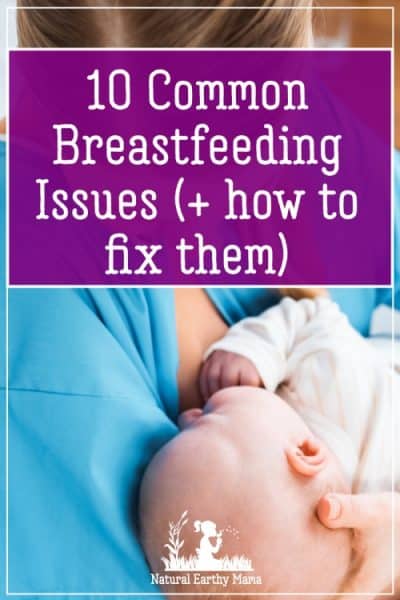 Only 40% of all infants are breastfed during the first six months of their lives. This number is often surprising but has a lot to do with lingering breastfeeding problems that are unable to be resolved.
Only 40% of all infants are breastfed during the first six months of their lives. This number is often surprising but has a lot to do with lingering breastfeeding problems that are unable to be resolved.
This guide is going to offer a peek into the ten most common breastfeeding problems and how to fix them easily so that your breastfeeding journey can be easy and fulfilling for both you and baby.
Please read: This information is provided for educational purposes only and is not intended to treat, diagnose or prevent any disease. We encourage you to make your own health care decisions in partnership with a qualified health care professional.
This post contains affiliate links, this means at no extra cost to you, we make a commission from sales. Please read
our Disclosure Statement
10 Common Breastfeeding Problems And How To Fix Them
1. Clogged Ducts
This occurs when the duct becomes blocked and the area around it is tender. This leads to the milk becoming trapped inside the milk ducts without a way out. As a result, many mothers start to report signs of discomfort and/or pain depending on their particular situation.
To fix this problem, it’s important to get as much rest as possible. This will allow the area to heal. You should also look into using warm compresses as a way to alleviate some of the soreness.
Try hand expressing your milk in the shower while massaging firmly in front of the blockage to try and encourage the thickened milk plug to loosen and move.
Sometimes a breastpump or a willing partner are better at clearing a blocked duct than hand expressing or baby feeding is.
2. Pain From Latching
In some cases, a woman may feel a high amount of pain during the latching process. This will vary from person to person but can make breastfeeding incredibly stressful and many women give up breastfeeding (and rightly so) when the thought of feeding their baby just brings them to tears.
To avoid dealing with latching-related pain, it’s best to focus on having the baby’s mouth cover the bottom half of the areola.
This can help eliminate some of the pain that’s associated with the latching phase. Over time, you will be able to adjust and that’s when the process is going to become easier.
Babies with high pallets, tongue ties or a shallow latch are more likely to cause pain on latching. It is normal in the early days for it to hurt as they latch, but the pain should quickly settle.
If when you unlatch, your nipple is white or pinched looking, your latch is not quite right. Work with your midwife or a lactation consultant to improve your latch.

3. Excessive Milk Production
Instead of dealing with too little milk, some women have the opposite problem where they’re troubled by engorgement (excess milk). This can lead to moments of serious discomfort.
When there is too much milk, there are different solutions that can be used to alleviate the problem. One of the solutions would be to breastfeed as often as baby will take it.
However, as milk is made to demand, and you want your baby getting plenty of the fattier hind milk, it is best to feed just from one side for 2 feeds, and then swap to the other side for the next feed.
This reduced stimulation on the rested side will encourage that side to make less milk, as well as allowing baby to get the fattier hind milk on the first side with the second feed.
Feeding baby while laying on your back can help slow your flow if you are finding baby is struggling to keep up with the milk.
4. Cracked Nipples
In some cases, women tend to deal with issues involving cracked nipples. This occurs when sores develop around the nipples that can lead to heightened soreness/sensitivity in the area.
Try to keep your nursing sessions short, as soon as baby is just playing, remove them gently. Make sure you have a nice deep latch. You should also look to keep the nipples as moist as possible after nursing.
If you already have cracked nipples, nipple shields, lanolin and hydrogel pads are total lifesavers.
5. Thrush in the breast
This is a yeast infection that can develop on the breasts and can become a serious problem for women.
You may exhibit multiple symptoms including fever and feeling like you have a flu, but the most common description of a thrush infection is feeling like you are being stabbed with knives, or nipples filled with glass shards.
If your baby has thrush in her mouth, you are at greater risk of getting a breast thrush infection.
The best solution with thrush is to use anti-fungal medications for both you and your baby at the same time.
6. Low Milk Supply
While excess milk has been discussed, what if you end up dealing with the opposite and have a limited supply of milk?
This can be worrisome to mothers, in fact it is one of the most common causes for stopping breastfeeding.
Before you give up, please check that what you are actually experiencing a low milk supply – find out how here.
Instead of going into a state of panic, it’s important to stay calm and take action.
Improving your milk supply can be done by nursing and pumping as often as possible. Some herbs and medication may help as well, find out more here.
7. Mastitis
This is an infection of the breasts. In most cases, this occurs during the first six months of a baby’s life. When a woman is dealing with mastitis, she will notice tenderness, breast pain, burning, and flu-like symptoms.
To alleviate these concerns, it’s best to breastfeed as much as possible to keep the milk ducts drained. You should also visit a family physician and get a prescription for antibiotics very promptly as untreated mastitis can land you in hospital very quickly, being very unwell.
Untreated mastitis can lead to breast abscesses requiring surgical drainage, or full body sepsis (you can die from this!).
RELATED POST: The ultimate guide to breastfeeding
8. Baby Sleeping While Breastfeeding
Is your baby falling asleep while breastfeeding? This can happen from time to time and is a common problem women deal with particularly with jaundice newborns.
To make sure the baby isn’t sleeping while breastfeeding, the best solution is to keep the baby stimulated (i.e. talking to them or tickling their feet).
This will help to keep them awake and aware of their surroundings while they are feeding. Falling asleep at the end of a feed is normal, but if you have a jaundice infant, or one that needs to improve their weight gains, you need to try and keep them awake to get a really good feed before nap time.
RELATED POST: Breastfeeding is best for moms too
9. Painful Let-Down
Your let-down occurs when breast milk releases from the breasts. It’s a natural reaction but in some women, it can become a painful reality.
If you are experiencing a painful let-down, visit a family physician and get checked out for infection.
Warm compresses as you are starting to feed may also help reduce the pain that you experience.
10. Inverted Nipples
Inverted nipples mean the nipples don’t point outwards as they normally would. This can make breastfeeding nearly impossible without some specific help.
To fix this problem, it’s important to start using nipple shields and pumping before nursing the baby. This will help keep the nipples straight as they’re supposed to be.
If you have inverted nipples, it is worth working with a lactation consultant during pregnancy and immediately after birth to help correct the problem.
Breastfeeding is a beautiful part of life but these problems can get in the way on your breastfeeding journey. Instead of letting the issues dictate whether or not you breastfeed, it’s important to focus on the solutions as best as you can.
Remember, there is no guilt here, if the best option for you and your baby is to swap to a bottle, by all means, give it a try. Bottle feeding also doesn’t have to be forever, it is possible to swap to a bottle while you heal, and re-start breastfeeding at a later date.




